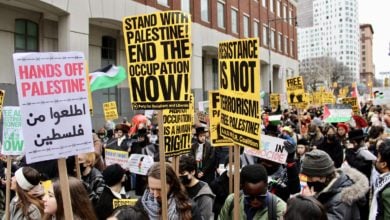Demonstrations on California’s university campuses marked the Thanksgiving holiday this year as students and faculty turned out in mass outrage over increased budget cuts and fee hikes for the 2010-2011 fiscal year.
 Students demonstrate at UCLA, Los Angeles, Calif., Nov. 19. |
The protests focused on the meetings scheduled for both the California State University and University of California systems that were expected to approve budgets with severe enrollment reductions and fee increases.
Hundreds gathered outside the CSU Board of Trustees two-day meeting in Long Beach on Nov. 17 and 18 as the board forged ahead with a budget that would slash CSU enrollment by 40,000 students by the end of 2010-2011 year.
The cutbacks also include a 30 percent increase in undergraduate fees. The CSU budget has been cut by close to 21 percent over the last two years. Faculty will also have to endure what amounts to a 10 percent pay cut in the way of furloughs.
Protesters picketed outside the meeting chanting “You say cutback, we say fight back” and “Money for jobs and education, not for banks and corporations.” Picketers then barricaded the entrances of the building after police prevented the students and faculty from entering the public meeting.
Despite police threats of arrests and physical violence, protesters held their ground. The chants were so loud that they could be heard loudly in the meeting hall. CSU Long Beach student Stevie Merino said: “We must continue to organize to stop the fee hikes and all future cuts to higher education. This is just the beginning, next time they see us on the streets we will be stronger and greater in numbers.”
Merino’s prognosis was right: A demonstration on UCLA’s campus on the following day set the stage for a struggle that would play out throughout the state over the next few days.
Police repression met with heightened militancy
Several thousand students protested the UC regents meeting on November 18 and 19. At that meeting, UC regents decided to raise student fees by 32 percent, bringing the average annual cost to about $10,300 per student. The cutbacks are on top of faculty furloughs and layoffs.
The first day of actions witnessed students interrupting the meeting twice by chanting in the meeting room and refusing to leave. Outside the meeting, police attacked demonstrators and tasered at least one student in an attempt to terrorize and disperse protesters.
This had the opposite effect: Realizing that the cops were sending to jail students who were fighting for access to quality education, protesters became more emboldened. That day, 14 people were arrested.
Students from all over California converged on the UCLA campus that night in response to the taserings and police repression. Students set up a tent city on the campus and more than 30 students occupied Campbell Hall, renaming it “Carter-Huggins Hall” in memory of Black Panthers Bunchy Carter and John Huggins who were murdered there in 1969.
Demonstrations continued into the next day. Students marched throughout the campus, disrupting classes and recruiting other students and faculty members along the way. The protest flooded out into the streets, bringing traffic to a halt at major intersections in the Westwood area for over an hour.
After hearing news that the cutbacks had been approved, students took steps to prevent the regents from leaving their meeting without hearing their demands one last time. When students blocked the van carrying the regents, University of California cops unleashed violence once more, striking protesters with batons and tasering another student.
A statewide movement
Campuses throughout California witnessed similar protests. At UC Berkeley, 40 protesters barricaded themselves inside Wheeler Hall in opposition to the fee increase and to demand the jobs of 38 custodians who were laid off earlier this year. The students’ demands also included funding for more affordable housing, also gutted earlier this year.
Four local police departments were called in to terrorize the occupiers and the solidarity protests that now numbered more than 2,000 people. At least one student was shot with a rubber bullet.
Asaf Shalev, one of the students occupying Wheeler Hall, said the following to Liberation newspaper about the action: “Our immediate demands have not been met yet, but we brought this to national attention. We made our struggle visible to the rest of the world. We’re building workers and students solidarity.”
Similar demonstrations and occupations occurred at UC Davis and UC Santa Cruz, where hundreds occupied campus spaces and thousands marched on school grounds.
Who will stop the cutbacks?
The reality for higher education in the short term is stark, but the potential for a burgeoning united student and workers movement has never been better. The capitalists will continue to unload the burden of the economic crisis onto the shoulders of working-class people; it is up to us to organize and beat them back.
The Party for Socialism and Liberation was proud to join students, faculty and workers from all walks of life at the occupations and demonstrations of the Cal State and UC campuses.
The students of state universities in California have set an example for the workers and students across the country. Mass mobilization and organization are a must to push back the attacks on education, working and living conditions.
We demand amnesty for all those arrested during the UC protests, an end to the furloughs, budget cuts and fee hikes and, ultimately, the right to free, quality education.






